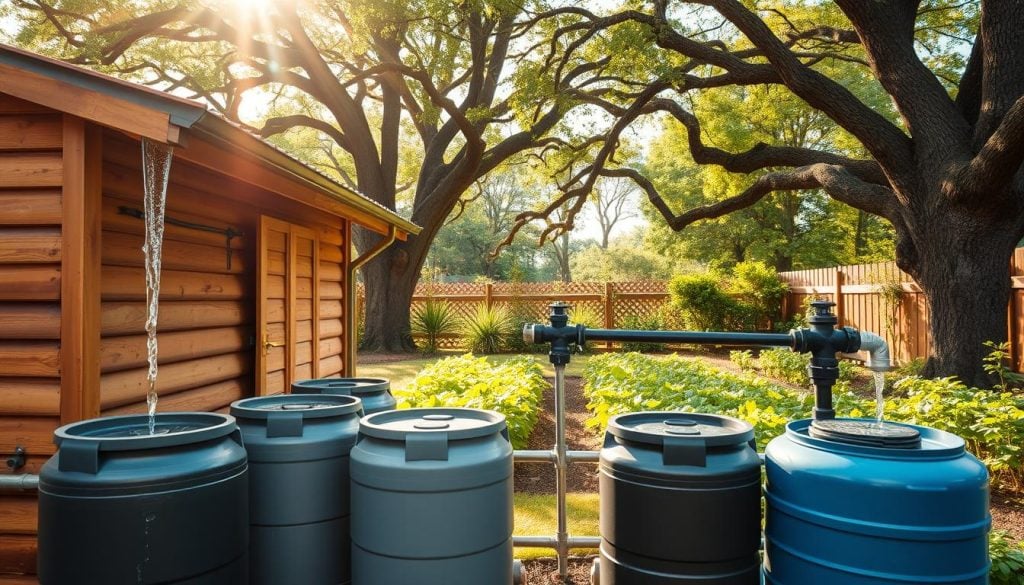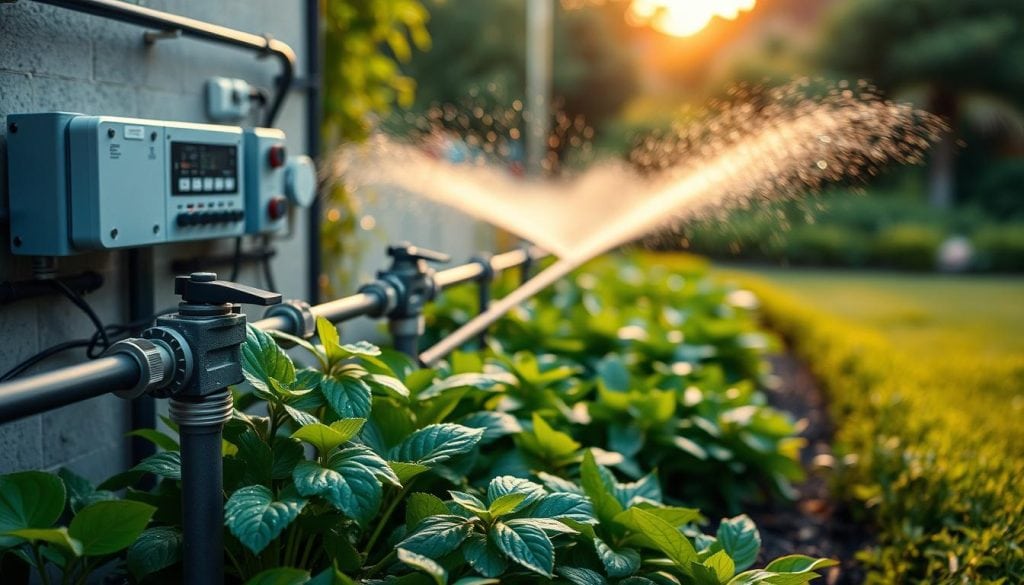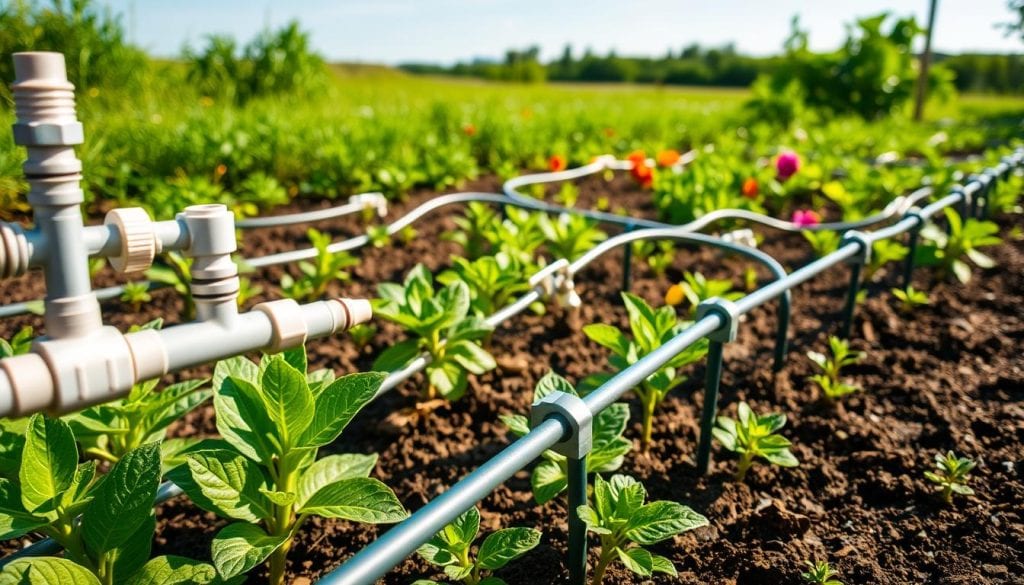Ever wondered how to slash your water bills while helping the environment? Capturing rainfall isn’t just for farmers – it’s a smart move for Aussie households too. With droughts becoming more common, many are turning to simple yet effective solutions to secure their water supply.
These setups catch water from your roof surface, store it safely in a water tank, and let you reuse it for gardens, laundry, or even toilets. Think of it as recycling nature’s gift – every drop counts when water restrictions hit, especially when considering the amount of precipitation we receive. Better yet, you’ll reduce pressure on mains supplies during peak summer months by using rainwater for your water supply.
From basic barrels to full-property rainwater harvesting systems, there’s an option for every budget. Modern designs blend seamlessly with homes while meeting strict Australian standards. Whether you’re in bushfire-prone areas or urban suburbs, this guide shows you how to get started with your collection system and manage water levels effectively.
Key Takeaways
- Reduces reliance on mains water by up to 40% for average homes
- Works in both urban and rural areas across Australia
- Can be scaled from simple tanks to whole-house setups
- Helps manage stormwater runoff during heavy rains and catch large debris
- Qualifies for rebates in many council areas
Understanding Rainwater Harvesting Systems
What if your roof could help cut your water bills? Across Australia, smart homeowners are tapping into free water supplies right above their heads. Let’s explore how this practical approach works and why it’s perfect for our climate.
Rainwater harvesting systems provide an eco-friendly way to collect and reuse rainwater, helping reduce water bills and support sustainable landscaping. From basic barrels to advanced tank systems, they can be tailored to fit your property’s needs.
Professional landscaping services can design and install efficient rainwater systems, ensuring proper drainage and integration with your landscape for long-term results.
How Does It Work?
This method catches rainfall from rooftops using gutters. The water flows into storage tanks through pipes. Basic setups use small barrels, while advanced versions connect to household plumbing. Filters keep leaves and debris out, ensuring clean storage. This rainwater harvesting system is designed to maximize the amount of water collected efficiently.
Why It Makes Sense Here
Australia’s dry spells and unpredictable rains make every drop of water precious. Using collected water for gardens or laundry eases pressure on mains supplies. Many councils offer rebates, making it budget-friendly too. This collection system helps manage water levels effectively, allowing homeowners to use rainwater sustainably.
| Benefit | Impact | Suitable For |
|---|---|---|
| Lower Bills | 40% mains water reduction | Urban homes |
| Drought Protection | Backup supply for 3+ months | Rural properties |
| Eco Boost | Reduces stormwater pollution | All households |
Take the Jones family in Brisbane – they water their veggie patch year-round using stored roof water. Their tank refills during summer storms, keeping their garden lush even during restrictions. This system allows them to manage their water level efficiently.
Key Components and Operation of Rainwater Harvesting Systems
Ever noticed how a well-built machine needs all its parts working together? Your water-saving setup works the same way. Let’s break down what keeps it running smoothly.
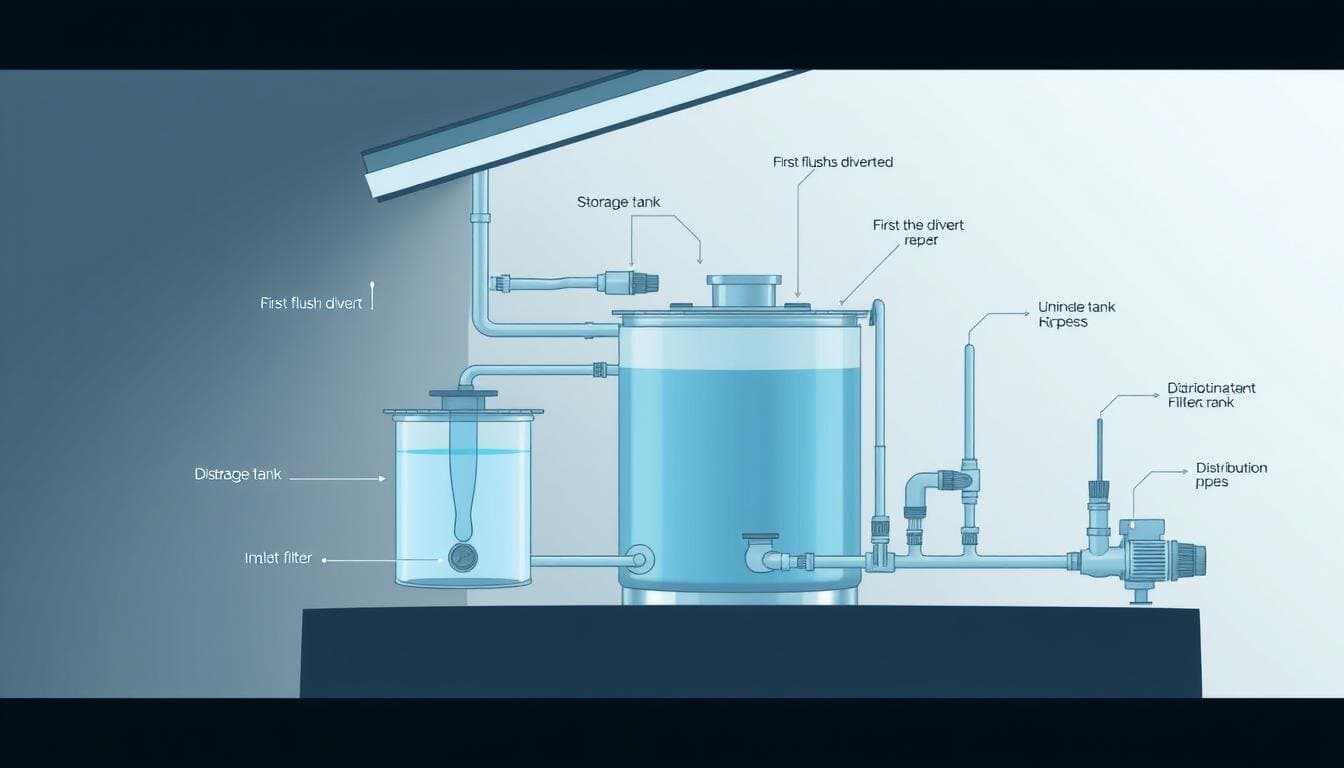
Essential Collection and Filtration Components
Your roof acts like a giant catcher’s mitt for rainfall. Gutters channel every drop of water into pipes leading to storage. But before water hits the tank, it passes through three key defenders:
- Mesh screens that block leaves and twigs
- A first-flush diverter that discards the initial dirty flow
- Food-grade tanks preventing algae growth
Take the Smiths in Sydney – their diverter stops 90% of roof dust from entering storage. Cleaner water means less filter changes. This information is crucial for effective rainwater harvesting systems.
Operational Controls and Maintenance Needs
Smart systems don’t just store water – they manage it. Modern setups use:
| Component | Function | Check Frequency |
|---|---|---|
| Float switches | Monitor tank levels | Every 6 months |
| Pressure pumps | Push water to taps | Annual service |
| Backflow valves | Prevent contamination | Bi-annual test |
A quick monthly gutter clean and quarterly filter check keeps everything flowing. Most parts last 10+ years with basic care. The amount of water collected can significantly impact your water usage.
Comparing Wet and Dry Systems for Rainwater Collection
Choosing between water storage setups can feel like picking between two good mates – each has strengths for different situations. Your property’s layout and budget often decide which approach works best. Let’s explore how these methods handle roof runoff and what makes them unique.
Advantages of Wet Systems
Wet setups use underground pipes that stay filled between rains. This lets you hide tanks behind sheds or gardens, keeping your yard tidy. A family in Adelaide saved space by tucking their storage 15 metres from the house, using gravity-fed lines from all four gutters. This system effectively utilizes the surface area of the roof for maximum rainwater collection.
These systems excel at gathering water from complex roofs with multiple angles. But they need trench digging and careful slope calculations. Learn more about plumbing considerations if you’re planning buried lines.
Benefits of Dry Systems
Dry versions keep pipes exposed and empty after each storm. A Melbourne couple installed theirs in a weekend using basic tools, connecting gutters directly to their tank’s top. No standing water means fewer mozzies and simpler upkeep.
These setups cost less upfront – perfect when tanks sit near buildings. They’re also easier to inspect for blockages. For tips on managing heavy flows, see our guide to effective water management.
| Feature | Wet System | Dry System | Best For |
|---|---|---|---|
| Pipe Position | Underground | Above Ground | Hidden tanks |
| Water in Pipes | Always present | Drains fully | Low maintenance |
| Installation Cost | Higher | Lower | Budget projects |
Still unsure? Ask yourself: How far is my tank from the roof? Do I mind occasional pipe checks? Your answers will point you toward the right solution.
Sizing, Installation and Maintenance Best Practices
Want your setup to work smarter, not harder? Getting the right tank size and nailing installation details makes all the difference. Picture this: A family in Perth cut their summer water bills by 60% after matching their storage to local rainfall patterns.
Proper sizing, installation, and maintenance are critical to the long-term success of any irrigation system. An accurately sized system ensures efficient water distribution, prevents pressure issues, and meets the specific needs of your landscape. During installation, it’s important to follow manufacturer guidelines, use quality components, and account for soil type, plant requirements, and slope. Regular maintenance—like checking for leaks, cleaning filters, and adjusting spray patterns—helps extend the system’s life and optimize performance.
A well-planned irrigation system design takes all these factors into account, creating a layout that promotes uniform coverage, reduces water waste, and supports healthy plant growth. Whether for residential or commercial properties, investing in smart design and routine care leads to a more sustainable and cost-effective landscape.
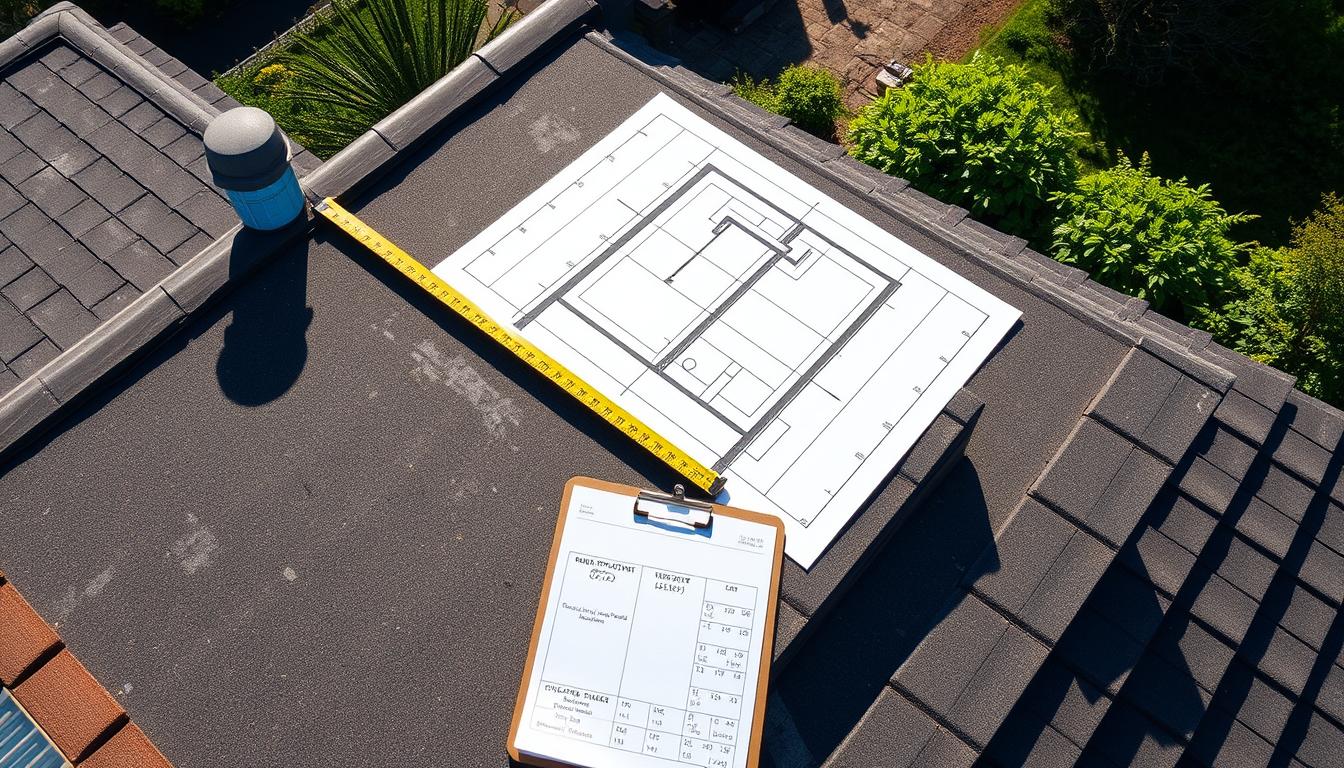
Calculating Roof Catchment and Storage Needs
Start with your roof’s surface area – every square metre counts. Multiply it by your area’s average monthly rainfall (in millimetres), then by 0.62. That magic number shows how much you could collect. But remember: pipes and filters always steal 10-25% through evaporation or overflow.
Here’s a real example: 200m² roof × 50mm rain × 0.62 = 6,200 litres. Factor in 80% efficiency? You’ll bank about 4,960 litres monthly. Use the Bureau of Meteorology’s rainfall maps to nail your local numbers.
| Factor | Recommendation | Why It Matters |
|---|---|---|
| Tank Capacity | Match 3-month demand | Survives dry spells |
| Roof Pitch | 15° minimum | Boosts water flow |
| Pipe Slope | 2cm per metre | Prevents blockages |
Routine System Maintenance Strategies
Weekly gutter sweeps stop leaves from clogging your first flush diverter. Check tank screens monthly – especially after storms. That Brisbane couple who found frogs in their overflow pipe? They now do quarterly pipe inspections.
Stick to this simple schedule:
- Every 7 days: Clear roof debris
- Every 30 days: Test pump pressure
- Every 6 months: Scrub tank walls
Pair these habits with smart water conservation techniques for maximum savings. Remember: A well-maintained setup lasts decades, not years.
Benefits and Applications of Harvested Rainwater
Imagine turning storm clouds into savings while protecting local ecosystems. Collected roof water offers surprising versatility beyond just keeping plants alive. Let’s explore how this resource boosts both your wallet and the environment.
Environmental and Economic Gains
Every litre you collect means less strain on rivers and reservoirs. Gardens thrive with chemical-free hydration – plants absorb nutrients more easily without chlorine. A Melbourne study found veggies grown with stored roof water yielded 23% more produce.
Homeowners save an average $580 yearly by using free water for laundry and gardens. Councils reward eco-conscious residents too – some offer $200 rebates for installing approved tanks.
| Benefit | Savings | Common Uses |
|---|---|---|
| Lower Bills | $120-$800/year | Irrigation, car washing |
| Stormwater Control | 45% runoff reduction | Flood prevention |
| Emergency Backup | 7-21 days supply | Drinking (filtered) |
Flexible setups let you start small. A Geelong family began with a single tank for their veggie patch, later expanding to service their entire laundry. Sustainable landscape designs often integrate these systems seamlessly.
During droughts, stored water becomes priceless. One Adelaide household avoided restrictions by using their 22,000-litre supply for pool topping and pet care. Properly filtered water even works in industrial settings – a Perth workshop cuts mains use by 70% for equipment cleaning.
Simple maintenance keeps costs low. Clear gutters monthly, check filters quarterly, and enjoy free hydration for decades. Why pay for water when nature delivers it pre-packaged?
Optimising Your Rainwater Collection and Usage
Clean water starts before it even hits your tank. Smart homeowners know that better filtration means more flexibility – whether you’re watering veggies or flushing toilets. Let’s explore how to keep your supply crisp and reliable year-round.
Enhancing Water Quality and Filtration
Your first defence? A first-flush diverter that kicks out the initial dirty flow from roofs. The Smiths in Melbourne saw a 60% drop in tank sediment after installing one. Pair this with mesh screens that catch leaves, and you’ve blocked most debris at the source.
Rainwater Harvesting Systems
Three-stage filtering works best for households:
| Stage | Function | Example |
|---|---|---|
| 1. Pre-filter | Traps large particles | 1mm mesh screen |
| 2. Sediment removal | Catches fine grit | 20-micron cartridge |
| 3. Disinfection | Kills microbes | UV light unit |
Check filters monthly – clogged screens strain pumps and breed bacteria. A Brisbane family learned this the hard way when their irrigation lines jammed during storm season. Quick tip: Mark replacement dates on your calendar!
For drinking water, add activated carbon and UV treatment. These remove chemicals and pathogens, meeting Aussie safety standards. Always test treated water quarterly for pH and clarity.
Smart monitors track tank levels via phone apps. Know when to conserve during dry spells or ramp up garden watering before rains. Why settle for basic filtration when your setup could rival bottled quality?
Conclusion
What if every downpour could boost your household’s independence? Across Australia, smart water collection setups are proving you don’t need elaborate tech to make nature work for you. From suburban gardens to rural properties, these solutions turn weather patterns into practical savings.
Whether you choose compact tanks or whole-property systems, the benefits stack up quickly. Reduced bills, greener gardens, and drought resilience come standard. Many Aussie homes now combine their setup with solar panels for complete off-grid water security.
Proper maintenance keeps your investment secure. A quick monthly gutter check takes less time than brewing coffee. Those who stay consistent often see their equipment last 15+ years – like the Perth family who’ve used the same tank since 2009.
Ready to start? Begin by calculating your roof’s potential using free online tools. Local councils often offer rebates that slash installation costs. Remember: Every litre collected means less strain on our rivers and reservoirs.
Final thought: Water collection isn’t just about saving money – it’s about future-proofing your home. With climate shifts affecting rainfall patterns, having your own supply brings peace of mind that’s worth every drop.
FAQ
How much rainfall do I need to make a storage tank worthwhile?
Even light rainfall adds up quickly – a 100m² roof catches about 5,000 litres of water rainwater from just 50mm of rain. Most Australian homes benefit from storage tanks, though arid regions might need larger capacities to accommodate the amount water collected.
What’s the easiest way to stop leaves clogging my gutters?
Fit leaf eaters or mesh guards – Bunnings’ Rola Gutter Mesh works well. Clean gutters every 3-6 months, especially before wet seasons. A story: My neighbour’s system failed during storms because one gum leaf blocked their downpipe!
Can I drink water from my tank if I filter it?
While first flush diverters and UV filters improve quality, health authorities recommend using collected water only for gardens, toilets and laundry unless professionally treated. Check your council’s guidelines first.
How often should I check the pump and pipes?
Test pumps monthly – listen for odd noises. Inspect pipes every season for cracks or leaks. Pro tip: Mark maintenance dates on your calendar like dentist appointments – it works!
Do wet systems really grow mosquitoes?
Only if poorly maintained. Use tight tank lids and mosquito screens on inlets. Darwin households manage this successfully – it’s about regular checks, not the system type.
Will a small tank help during water restrictions?
Absolutely! A 2,000L slimline tank waters gardens for weeks. During Melbourne’s last drought, my herb garden thrived while others’ died – every litre counts, especially in this area.
What’s the biggest mistake new users make?
Forgetting the first flush diverter. Without it, that initial dirty roof water contaminates your whole tank. Spend $150-$300 on a good one – it’s cheaper than cleaning sludge later!
Can I connect the system to my existing plumbing?
Licensed plumbers must do this under AS/NZS 3500.1. Brands like Davey make retrofit kits, but check local regulations. Some councils offer rebates for proper installations.

